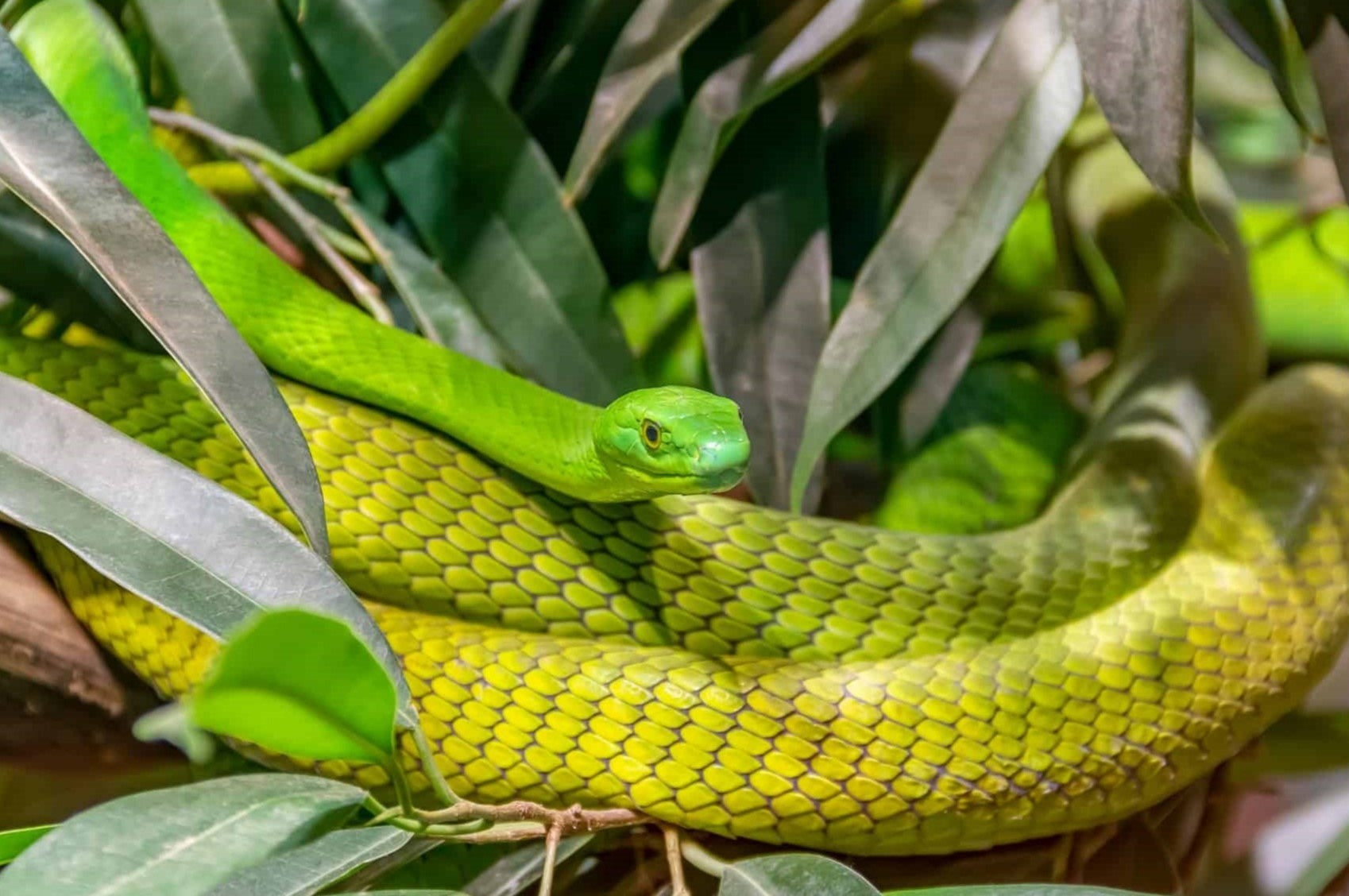
The Western Green Mamba, also known as Dendroaspis angusticeps, is a fascinating species of snake that holds numerous intriguing facts and characteristics. This species is native to various regions in Africa, including South Africa, Namibia, and Angola. The Western Green Mamba belongs to the family Elapidae, which includes venomous snakes such as cobras and coral snakes.
Revered for its vibrant green coloration and incredible speed, the Western Green Mamba is a creature that captivates both snake enthusiasts and researchers alike. Its slender body, agility, and potent venom make it an apex predator in its habitat. In this article, we will explore 19 unbelievable facts about the Western Green Mamba, shedding light on its physical attributes, behavior, diet, and the importance of conserving this remarkable snake species.
Key Takeaways:
- The Western Green Mamba is a deadly, vibrant green snake native to West African rainforests. It plays a crucial role in its ecosystem and is protected due to habitat loss and illegal wildlife trade.
- With its potent venom, arboreal lifestyle, and unique warning display, the Western Green Mamba is a fascinating and important species that deserves our understanding and conservation efforts.
The Western Green Mamba is one of the deadliest snakes in the world.
The venom of the Western Green Mamba is highly potent and can cause rapid paralysis, leading to respiratory failure.
It is native to the rainforests of West Africa.
The Western Green Mamba can be found in countries such as Nigeria, Cameroon, Ivory Coast, and Ghana.
The Western Green Mamba is known for its vibrant green color.
Its bright green scales blend perfectly with the lush green foliage of its natural habitat, making it difficult to spot.
These snakes can grow up to 6 feet in length.
The Western Green Mamba is a relatively large snake species, with males being slightly longer than females.
Western Green Mambas are incredibly agile and fast-moving.
With their slender bodies and excellent muscle control, they can swiftly navigate through trees and vegetation.
They are primarily arboreal, spending most of their time in trees.
The Western Green Mamba is highly adapted to an arboreal lifestyle, using its long and prehensile tail to grip branches.
Their diet consists mainly of small mammals and birds.
These snakes possess powerful jaws and sharp fangs, allowing them to capture and devour their prey with ease.
The venom of the Western Green Mamba is a potent neurotoxin.
Once injected into its victim, the venom attacks the nervous system, causing paralysis and, if left untreated, can be fatal.
The Western Green Mamba is not an aggressive snake.
It prefers to avoid human encounters and will typically only strike if it feels threatened or cornered.
They have excellent eyesight and are capable of seeing in color.
This allows the Western Green Mamba to spot its prey and potential threats with great accuracy.
The mating season for Western Green Mambas occurs during the rainy season.
Males will engage in combat to win the attention of a female, wrestling with each other for dominance.
Female Western Green Mambas lay clutches of 10-20 eggs.
The eggs are typically hidden in hollow trees or dense vegetation, where they will hatch after an incubation period of around 2-3 months.
Western Green Mambas are excellent swimmers.
They can easily navigate through water, using their long and sleek bodies to propel themselves forward.
The Western Green Mamba has a lifespan of around 10-15 years in the wild.
However, in captivity, they can live up to 20 years with proper care and husbandry.
These snakes are highly sensitive to vibrations.
They can detect the slightest movement in their surroundings, which aids them in hunting and avoiding potential threats.
Western Green Mambas play a vital role in the ecosystem.
As top predators, they help control the populations of small mammals and birds, contributing to the balance of their ecosystem.
The Western Green Mamba is a protected species.
Due to the threat of habitat loss and illegal wildlife trade, conservation efforts are in place to ensure their survival in the wild.
Western Green Mambas have a distinct warning display.
When threatened, they will flatten their necks and open their mouths wide, displaying their black oral cavity as a warning sign.
The Western Green Mamba’s scientific name is Dendroaspis viridis.
This species falls under the family Elapidae, which includes other venomous snakes like cobras and coral snakes.
Learn More About the Western Green Mamba
These 19 unbelievable facts about the Western Green Mamba give us a fascinating insight into the world of one of the most intriguing snakes in existence. From their deadly venom to their arboreal lifestyle, these reptiles have captivated researchers and snake enthusiasts alike. By understanding and appreciating these incredible creatures, we can work towards ensuring their conservation and the preservation of their natural habitat.
Conclusion
The Western Green Mamba is truly a fascinating creature with its vibrant green color and deadly venom. With its remarkable abilities and unique characteristics, it has secured its place as one of the most impressive snakes in the world.From its incredible speed and agility to its ability to hunt both on land and in trees, the Western Green Mamba has proven itself to be a remarkable predator. Its venom, while dangerous, is also being studied for its potential medical applications.Despite its intimidating reputation, it is important to remember that the Western Green Mamba plays an important role in its ecosystem. By controlling populations of prey species, it contributes to the balance of nature.By learning more about these remarkable creatures, we can better appreciate the beauty and diversity of wildlife. The Western Green Mamba serves as a reminder of the wonders that exist in the animal kingdom and the importance of protecting these species for future generations.
FAQs
Q: What is the Western Green Mamba’s habitat?
A: The Western Green Mamba can be found in the tropical forests and savannas of Western Africa, particularly in countries such as Ghana, Nigeria, and Cameroon.
Q: How long can the Western Green Mamba grow?
A: Adult Western Green Mambas can reach lengths of up to 6.5 feet (2 meters).
Q: Are Western Green Mambas aggressive towards humans?
A: Western Green Mambas are generally shy and elusive, preferring to avoid human interaction. However, they can become aggressive if they feel threatened or cornered.
Q: What is the Western Green Mamba’s primary food source?
A: The Western Green Mamba primarily preys on small mammals, birds, and reptiles.
Q: Is the Western Green Mamba endangered?
A: The Western Green Mamba is not currently listed as endangered. However, habitat loss and illegal trade pose threats to their populations.
Intrigued by Western Green Mambas? Dive deeper into the fascinating world of snakes with our captivating article on snake facts. Explore the incredible diversity of reptiles through 14 astounding facts that will leave you in awe. If you're curious about nature's most potent predators, don't miss our piece on the world's most venomous snakes, featuring jaw-dropping details about their deadly abilities.
Was this page helpful?
Our commitment to delivering trustworthy and engaging content is at the heart of what we do. Each fact on our site is contributed by real users like you, bringing a wealth of diverse insights and information. To ensure the highest standards of accuracy and reliability, our dedicated editors meticulously review each submission. This process guarantees that the facts we share are not only fascinating but also credible. Trust in our commitment to quality and authenticity as you explore and learn with us.


